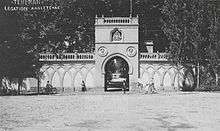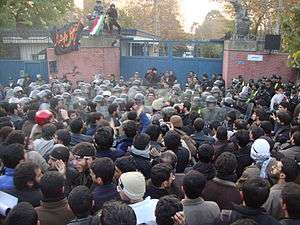Embassy of the United Kingdom, Tehran
| Embassy of the United Kingdom in Tehran | |
|---|---|
|
| |
| Coordinates | 35°41′47.5″N 51°25′06.7″E / 35.696528°N 51.418528°ECoordinates: 35°41′47.5″N 51°25′06.7″E / 35.696528°N 51.418528°E |
| Location |
|
| Address | 198 Ferdowsi Avenue, Tehran |
| Website | Office website |
The Embassy of the United Kingdom in Tehran is the United Kingdom's diplomatic mission to the Islamic Republic of Iran. It is located at 198 Ferdowsi Avenue in Tehran .
Following the 2011 attack on the Embassy and the expulsion of the British ambassador by Iran, Britain reduced its diplomatic relations with Iran to "the lowest possible level" and closed its embassy.[1][2] However, following the election of President Hassan Rouhani, relations have improved and both countries appointed non-resident charge d'affaires to conduct bilateral relations between London and Tehran. The current charge d'affaires to Iran is Ajay Sharma.[3] The embassy reopened in August 2015.
History
The British Mission in Tehran was first established in 1821 in the Old Bazaar. By the 1860s, the overcrowding and poor sanitary conditions forced the government to look for a more suitable location and the Ferdowsi site was purchased. To supervise the construction of the new Legation Buildings, James Wild, the architect, was commissioned. He was an established architect with experience of the Middle East. The building was finished in June 1876.[4]
Persian Constitutional Revolution

Most famous of all the historical events associated with the embassy is the great 'bast' (meaning sanctuary) of July/August 1906 when, during the constitutional struggle, some 12-16,000 Tehranis took sanctuary in the compound and by thus paralysing the life of the city, forced Muzaffar-ud-din Shah to issue his celebrated Farman of 5 August 1906 granting the people a constitution and National Assembly.[4]
Iranian Revolution
Following the Islamic revolution in 1979, the British Embassy was placed under the protection of Sweden. In 1987, all staff were withdrawn from Tehran following a series of setbacks to relations. In November 1988, UK Foreign Minister Geoffrey Howe agreed with Iranian Foreign Minister Velayati to resume diplomatic contact. Staff returned in January of 1989.[4]
The Satanic Verses controversy
On 14 February 1989, Ayatollah Khomeini issued a fatwa against Salman Rushdie and his publishers. European Community Foreign Ministers agreed to withdraw their heads of mission from Tehran in response. The British Government withdrew all UK-based staff. Iraq’s invasion of Kuwait made it desirable to re-establish relations once more, in September 1990.[4]
Mykonos restaurant assassinations
The UK and all other EU countries withdrew their heads of mission in April 1997 when a German court issued a verdict that members of the Iranian intelligence services were responsible for the murder of four Iranian Kurds in Germany in 1992. Heads of mission returned in November 1997 following the election of President Khatami, who showed determination to pursue the establishment of a civil society and the rule of law, and to promote wider international understanding. Britain and Iran jointly upgraded the relationship to ambassadorial status in 1999.[4]
2011 British Embassy stormed
On 29 November 2011, two compounds of the British embassy in Tehran were stormed by Iranian protesters. The protesters smashed windows, ransacked offices, set fire to government documents, and burned a British flag.[5]
The storming of the British embassy followed from the 2011 joint American-British-Canadian sanctions and the Iranian government's Guardian Council approving a parliamentary bill expelling the British ambassador as a result of those sanctions. A British flag was taken down and replaced by the Iranian flag by the protesters. The British Foreign Office responded by saying "We are outraged by this. It is utterly unacceptable and we condemn it."[6] According to Iranian state news agencies, the protesters were largely composed of young adults. On 30 November 2011, in response to the attack, the UK closed its embassy in Tehran and ordered the Iranian embassy in London closed.[7]
Reestablishment of relations
In July 2013, it was announced that the UK would consider to open better relations with Iran "step-by-step" following the election of President Hassan Rouhani.[8] In November 2013, Iran and the UK agreed to end the protecting power arrangements of Sweden and Oman and appointed non-resident charge d'affaires to conduct bilateral relations between London and Tehran. In June 2014, the UK announced that it intended to reopen its embassy in Tehran once practical arrangements had been completed and predicted that Iran would reopen its embassy in London.[3] In August 2015, the embassy was reopened by Philip Hammond, the British Foreign Secretary.[9]
Gholhak Garden

Gholhak Garden (alternatively Qolhak Garden or Gulhak Garden) is a British diplomatic compound in the northern Tehran neighborhood of Gholhak in Iran, about 3 miles from the centre of Tehran. The sprawling tree-lined site, bordered by high walls, measures 200,000-square-metre (50 acres) and houses British diplomats and their families. The compound is also home to the Tehran War Cemetery.[10] The site has been at the centre of diplomatic controversy between Britain and Iran over ownership and management of the grounds.[10]
The Qajar monarchy gave the land for Gholhak Garden to the British in the 19th century at the height of their imperial power for their ambassador to use as a summer residence.[10]
Gholhak Garden is separate from the historic British embassy several miles south in central Tehran, where British ambassadors have now lived for decades. Today, several British diplomats and their families as well as some Iranian embassy staff reside in the Gholhak complex.[10][11]
The Islamic Republic of Iran, which has had strained relations with the United Kingdom, has on occasion demanded the return of the Gholhak property to Iran.
Gholhak Garden and the British embassy in central Tehran have been subject to periodic anti-Western demonstrations orchestrated by the Iranian government since the defunct American embassy has no longer been the central target after being taken over in 1979 during the Iran hostage crisis.[10]
On November 29, 2011, Iranian protesters stormed the British embassy in downtown Tehran and Gholhak Garden. The incident came amid rising tensions over Iran's nuclear program. The protesters broke into Gholhak and briefly seized six British embassy staff before being released by the Iranian police. Britain expressed outrage at the riots and warned of "serious consequences."[12]
See also
- Iran–United Kingdom relations
- List of diplomatic missions in Iran
- List of Ambassadors of the United Kingdom to Iran
References
- ↑ http://www.bbc.co.uk/news/uk-34031615
- ↑ http://www.bbc.co.uk/news/uk-34038091
- 1 2 "UK for Iranians". Gov.uk. Retrieved 2 May 2015.
- 1 2 3 4 5 "Embassy History". Internet Archive. Retrieved 2 May 2015.
- ↑ "Iran protesters storm UK embassy in Tehran". BBC. 29 November 2011. Retrieved 29 November 2011.
- ↑ "Iranian protesters storm British diplomatic compounds". Reuters. 29 November 2011.
- ↑ Borger, Julian (30 November 2011). "Britain expels Iranian diplomats and closes Tehran embassy". The Guardian (London).
- ↑ "Britain says open to better relations with Iran". Tehran Times. Retrieved 5 August 2013.
- ↑ Associated Press (23 August 2015). "British Foreign Secretary Reopens Embassy in Tehran". Wall Street Journal. Retrieved 23 August 2015.
- 1 2 3 4 5 Michael Theodoulou (22 November 2011). "Iran fines British embassy for 'environmental vandalism' in Tehran compound". The National. Retrieved 24 November 2011.
- ↑ Robert Tait (17 July 2007). "Iranian militants demand return of British diplomatic compound". The Guardian. Retrieved 19 November 2011.
- ↑ Robin Pomeroy (29 November 2011). "Iranian protesters storm UK diplomatic compounds". Reuters. Retrieved 29 November 2011.
| ||||||||||||||||||||||||

.svg.png)